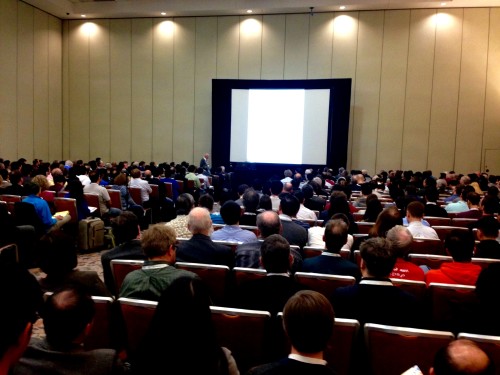
Packed in: a full room for Anthony Leggett’s talk. (Courtesy: Tushna Commissariat)
By Tushna Commissariat in Baltimore, Maryland, US
One of the most popular talks this morning at the APS March meeting was almost certainly given by Nobel-prize-winning physicist Anthony Leggett of the University of Illinois at Urbana-Champaign in the US. Leggett, who shared the 2003 Nobel Prize for Physics for his work on superconductors and superfluids, talked about his “Reflections on the past present and future of of condensed-matter physics”.
As the abstract of his talk suggests, Leggett looked at the ways, means and even the very definition of “condensed-matter physics” has changed and “evolved since its inception in the early 20th century, with particular reference to its relationship to neighbouring and even distant disciplines”. He went on to “speculate on some possible directions in which the discipline may develop over the next few decades, emphasizing that there are still some very basic questions to which we currently have no satisfactory answers”.
I missed the beginning of his talk as I was attending the morning’s first set of press briefings (more on those later) but when I did walk into the packed hall for his talk, his slide had the rather interesting title: “Would I encourage my grandchildren to go into condensed-matter physics?” Happlily enough, his answer at the end of his talk was a resounding “yes”.
A key point Leggett made was that what was experimentally unthinkable even 20 years ago – such as artificial atoms and quantum superpositions – are commonplace today, showing just how much the field has grown. Some areas of particular interest for him in the future include the emergence of “space–time” in condensed-matter systems, as well as topological and emergent phenomena.
An intriguing point he made was that scientists should be delving into those “slippery issues in science where we don’t know what questions to ask”. Indeed, he suggested that these areas, by definition, do not fall under the bounds of “normal science” and so “we may need to actively push the borrders” of condensed-matter physics. Interestingly, when someone asked Leggett for his views on quantum computing, he was quick to say that researchers should begin looking at what exciting work could be done with a quantum computer, were it to be built, beyond the applications of quantum cryptography.
I did have a quick chat with Leggett at the end of his talk, mainly to ask his views on the quantum/classical border – a subject he is highly involved in thanks to his work on macrorealism. Leggett told me he and his colleagues have just published a paper on arXiv about “macroscopic realism in a superconducting flux qubit” that I look forward to digging into at a later date.
Trackback: Blog – physicsworld.com | Study Physics
Probably the most interesting field of condensed matter is the human brain itself with its web of billions of neurons and chemical conections that manifests different collective phenomena such as consciousness, language, complex dreams and nightmares and the creative inspiration- the ecstasy.